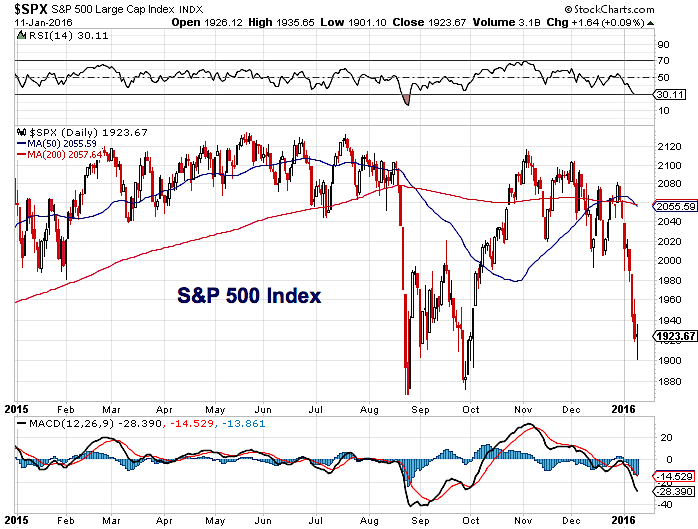Starting in the hole for the year sucks. It’s psychologically defeating and immediately makes you feel like you are playing catch up for the entire first quarter, if not the first half.
Most investors I speak with are rightfully scared and questioning the “buy the dip” game plan that worked so steadily over the last several years.
Will this time be different?
Before we weigh the bull and bear cases, let’s look at the numbers.
By the numbers, the SPDR S&P 500 ETF (SPY) is down 5.86% for 2016 and 8.71% from its all-time high (as of last week’s close). Those statistics wouldn’t be all that bad if it weren’t for the headlines that have ceremoniously declared this the worst start to the year EVER for the stock market.
SPY closed on Friday near $192 and the bears are likely salivating at the prospect of another test of the August closing low near $185. That’s a downside gap of 3.8% and will be a technically significant level for the market to hold. A confirmed break below that support line may lead to a secondary wave of fear and selling pressure that catapults us into a new downtrend for 2016.
The flip side is that some unforeseen force suddenly lifts us out of the abyss and runs the markets higher from here. It seems improbable (as all sharp rallies do) that such an event could occur. However, this is typically the sort of crestfallen sentiment that is needed to spark a big shift in the market. SPY rallied 7% in just eight trading days during late September through early October of 2015. Risk happens fast in both directions.
Let’s examine some of the bull and bear cases that are causing a disturbance this year.
Bearish Case
- The market is well below its long-term moving average and off to its statistically worst start to the year ever.
- We are experiencing deflationary commodity pressures alongside tightening risk in high yield credit securities.
- Small cap stocks have fallen significantly harder than their large-cap peers. Momentum leaders are also losing their mojo.
- Market breadth has virtually disintegrated and left the average stock in bear market territory when measured from its 52-week highs.
- The turmoil in the Chinese stock market appears to be having a profound spillover effect on U.S. markets.
- The Federal Reserve is beginning its first fiscal tightening cycle since pretty much anyone can remember.
Bullish Case
- Stocks are now in oversold territory based on relative strength readings and other technical metrics.
- The CBOE VIX Volatility Index (VIX) has reached a similar area (peak) where it was turned back in December 2015.
- The CNN Fear and Greed Index is registering extreme fear, which I can also confirm in the majority of my conversations with individual investors.
- Labor statistics show a continued strong pace of job growth and low unemployment readings.
- Many major banks and asset managers have come out with recent warnings to underweight or exit U.S. stocks. It is rare to see this level of concern this close to the highs.
- Pension and mutual fund assets are sitting on some of their highest cash levels in years.
There are countless other bullets that can be added to both of these bull and bear cases. Furthermore, there is no shortage of noise and banter about the fate of the markets at this juncture. Each opinion should be taken with a grain of salt and filtered through the lens of your current asset allocation, risk tolerance, and investment style.
Admittedly my bias remains on the long side as I have continued to hold on to core holdings for myself and clients. The bulk of our portfolios are arranged in a balanced multi-asset approach that leaves some flexibility for tactical holdings to be added or reduced as necessary.
My advice for those that find themselves out on a limb in terms of too much equity exposure or fearing the worst is to be opportunistic with any exit points. Use rallies to your advantage whenever possible rather than succumbing to the emotional trigger of a capitulation-style event. Despite the seeming undercurrent of despair, we may be nearing at least a short-term inflection point of relief.
Conversely, those that have been overly cautious should avoid rooting heavily for the end of the world. Taking a measured approach to putting money back to work for an anticipated bounce may allow you to capitalize on this sell off.
No matter what side you are rooting for, keeping a level-headed perspective and the ability to see both outcomes can improve your investment decision making process.
Twitter: @fabiancapital
Gather more insights from David’s investment blog.
Any opinions expressed herein are solely those of the author, and do not in any way represent the views or opinions of any other person or entity.








